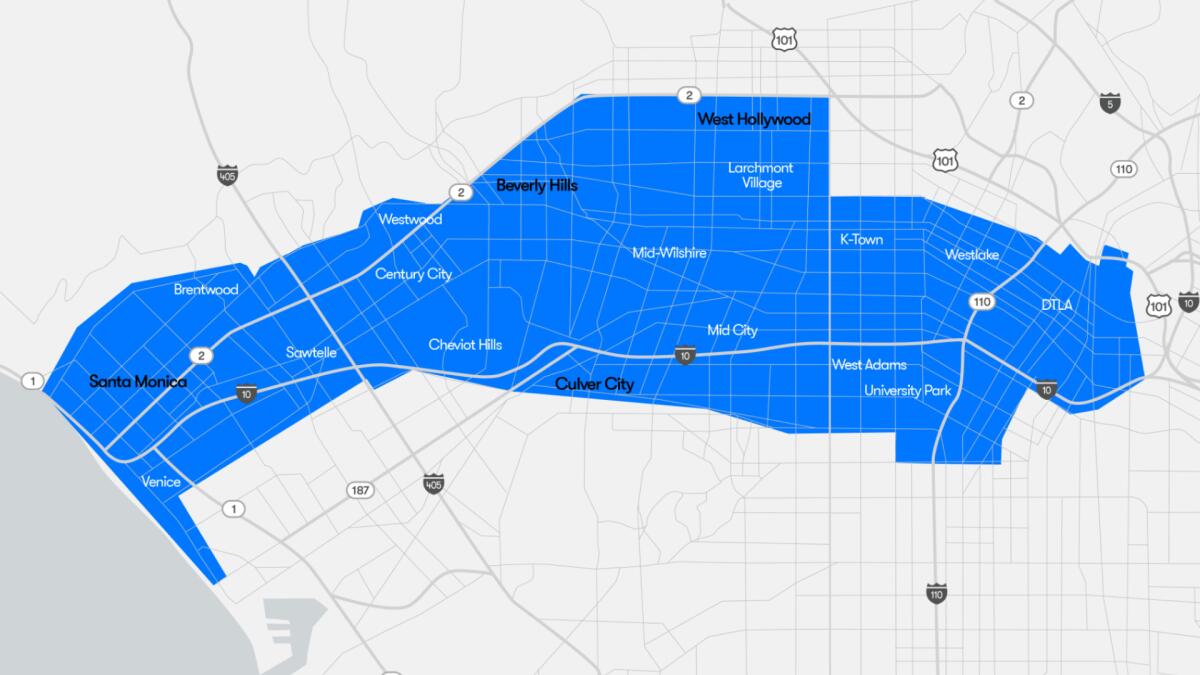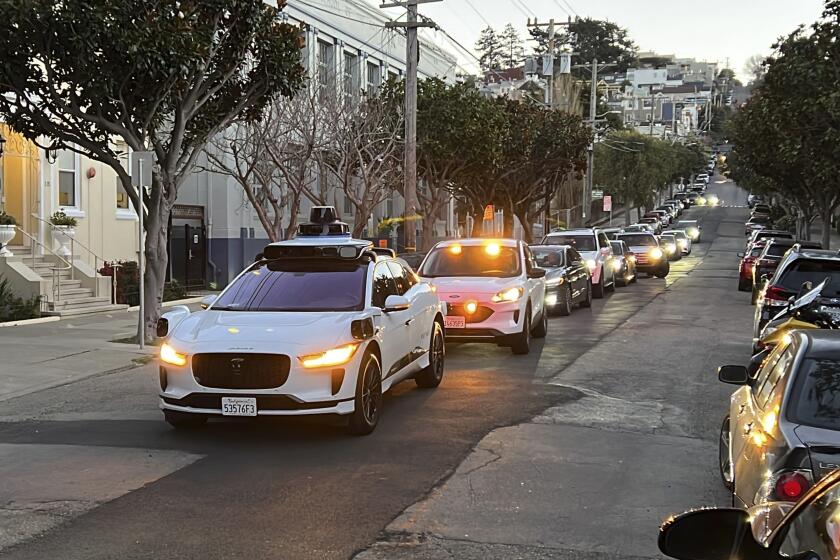Waymo to launch robotaxi service in Los Angeles, but no freeway driving — for now

- Share via
The driver in the Chevy Suburban seemed bent on testing the Waymo robotaxi on the streets of downtown L.A. this week.
Playing chicken against Silicon Valley’s wheeled robot, he sharply swung into the next lane toward the Waymo. The white, driverless Jaguar swerved to avoid the bigger car crossing the line.
The human driver then sped ahead of the robotaxi and braked abruptly in front of it. The machine slowed in time to avoid a collision, shifted into the next lane and the Chevy moved on, ending a brief yet anxiety-inducing interaction for a Los Angeles Times reporter and photographer riding in the Waymo vehicle.
Los Angeles, buckle up.
Robotaxis will begin doing business in L.A. over the next couple of weeks as regulators, developers, drivers, passengers and policymakers grapple with safety concerns and all the other scenarios that can play out when machines take over the wheel. Fender benders. Sex in the backseat. Serious crashes. Hostility. Awkward dropoff spots. And yes, skeptics who want to test the technology by putting obstacles in the way.
On Thursday, Waymo One, as the service is known, will begin offering rides across 63 square miles from downtown Los Angeles to Santa Monica. Waymo, owned by Google’s parent company, Alphabet, has already been in testing in Los Angeles-area neighborhoods for over a year. It rolled out a months-long “tour” in October, but until now, the service has been limited to small corners of the city and to those invited from a wait list.
The fleet will be less than 50 cars in L.A., said Waymo. But the fare charge debut in L.A. marks another major milestone for an industry once only imagined in science fiction. The fleet will descend on a city famous for its car culture and the identity people create around it. But no freeways for now, Waymo officials say; the cars will stick to surface streets.
The move comes less than a month after the California Public Utilities Commission, which oversees deployment of robotaxis, cleared the way for them in Los Angeles and cities across the Bay Area.

“This is going to revolutionize transportation, and people have a wide variety of comfort levels,” said David Margines, Waymo’s director of product management. “You always have people that are scared or nervous and take longer to accept new technology.”
But, Margines said, those who have used it tend to come back.
“They love it and what our users are saying is that they can’t wait for it to scale more,” he said. “They want to use Waymo for every one of the miles that they’re driving.”
More than 50,000 people have signed up for the wait list in Los Angeles. Waymo plans on providing free service for the next couple of weeks for those on the list before it transitions to paid fares through its app, much like Uber or Lyft.
Waymo already operates in San Francisco and Phoenix, where a series of recent incidents with robotaxis in both cities has further stoked existing safety concerns and evoked hostility.
Just last month in San Francisco, a driverless Waymo car crashed into a cyclist, causing minor injuries. The company said its robotaxi had been at a four-way stop when a large truck came into the intersection. The robotaxi waited for its turn, then proceeded through the intersection, but didn’t detect the cyclist behind the truck.
“When they became fully visible, our vehicle applied heavy braking but was not able to avoid the collision,” the company said.
Days later a small crowd lit an empty Waymo car on fire. Other residents in the city have put up cones and otherwise obstructed the vehicles.
With robotaxis being tested in Los Angeles, Mayor Karen Bass called on the state to increase scrutiny of the driverless vehicles before fully permitting them. She points to problems with the cars in San Francisco.
In Phoenix, Waymo cars hit the same towed pickup truck twice. The company said “the Waymo AV incorrectly predicted the future motion of the towed vehicle.” The incident prompted a voluntary recall of software.
In Los Angeles, also last month, a Waymo testing vehicle hit a closing gate at USC. Waymo said its car was leaving the campus after dropping off passengers when it drove up to the automatic gate as it was moving. The robotaxi braked but was hit by the gate, resulting in some minor scratches.
The ride taken by Times journalists on Monday afternoon demonstrated the shortfalls of automated technology. The car sometimes did its dropoff in front of driveways where cars were exiting, and with the Waymo microphones set to mute, there was no way to tell it to pull up farther.
At a corner near Crypto.com Arena, a group of teenagers on bikes were loudly telling police that a man had a gun. In most cases, drivers might hightail it out of there. But backseat driving instructions were again futile. There was nothing but a button to call customer service.
Luckily the man accused of having a gun eventually calmly walked over to police, while the Waymo car — already set to pull over near the stadium — stopped nearby. A few minutes later, along Skid Row, the car pulled up several feet from a tent. It was unclear if there was anybody inside, but a human driver might know this is impolite and awkward.
In San Francisco — where Waymo’s largest fleet of 250 robotaxis operate and residents have become more accustomed to their presence — there have been far more serious incidents. A Waymo robotaxi competitor, Cruise, dragged a person down a street last year and the company allegedly failed to disclose the footage to the state Department of Motor Vehicles, which regulates testing of driverless vehicles. The DMV suspended the General Motors-owned company’s permits and Cruise has since suspended U.S. operations.
While Cruise is sidelined, dozens of other robotaxi companies are testing on California streets. According to the DMV , as of Feb. 2, 38 companies had permits to test autonomous vehicles with a backup safety driver, six companies were permitted to test driverless vehicles and three manufacturers could deploy autonomous vehicles. No fatal incidents have been reported, and there have been few crashes with serious injury, according to the DMV.

But the expansion of robotaxis has sparked protests from local leaders over safety concerns, even as Waymo says its driverless cars have logged more than 7 million miles and are better than humans at avoiding collisions. There’s also growing anxiety among some who worry about the implications of a robot primed to take over tens of thousands of driving jobs across the county.
“People are worried that right now that the sophistication level of the AVs is limited,” said California state Sen. Dave Cortese (D-San José), who has introduced a bill that would give local officials more control of autonomous vehicles. Among other things, it would allow local government to cap the number of robotaxis and limit where the cars can drive.
He says cities should have the right to establish no-dropoff zones — for example, near schools — or restrict cars at airports and other locations without having to wait for legislators in Sacramento.
Driverless car technology company Motional will be putting autonomous Hyundai Ioniq 5 EVs on the road around L.A. as it looks to the city for engineering talent.
Mayor Karen Bass asked the CPUC in November to increase its scrutiny of the automated vehicle companies and said the city should have a say in how they are regulated.
At the time, she said one of the Waymo driverless cars operating in Los Angeles had failed to initially stop for a traffic officer at Beaudry Avenue and Wilshire Boulevard on Aug. 3, 2023. The officer had been signaling east- and westbound traffic to stop.
There are several other pieces of legislation to impose further regulations on the vehicles. California Assemblymember Matt Haney of San Francisco recently introduced a bill that would force autonomous vehicle companies in California to report to the DMV collisions, traffic violations, occurrences of the autonomous mode shutting down and alleged incidents of assault or harassment that would then be published online within 30 days. The bill would allow the public to submit reports of incidents.
Already, the DMV requires manufactures to report crashes with property damage, bodily injury or death within 10 days. And the agency can revoke permits or suspend permits when it determines an “unreasonable risk to public safety.”
But some question what the robotaxis, even if they are safe, have to offer society.
“There are very real social questions about what the future holds,” said Melissa Cefkin, a social and behavioral researcher specializing in people’s interaction with automated vehicles.
Tens of thousands of humans could lose jobs in the future — from taxi to truck drivers — and most people have had little say in whether, where and how this technology will be applied.
“I’m a citizen in the San Francisco Bay Area, and nobody reached out to me to say is that OK, we test our cars on public roads,” said Cefkin, a former researcher at Waymo and in Nissan’s autonomous vehicle lab. “Frankly, there are still questions about, is this important to bother with? Why is it such a big deal to get human drivers out of their seats? You know, there’s world hunger, there’s wars, there’s poverty.”
More to Read
Sign up for Essential California
The most important California stories and recommendations in your inbox every morning.
You may occasionally receive promotional content from the Los Angeles Times.















